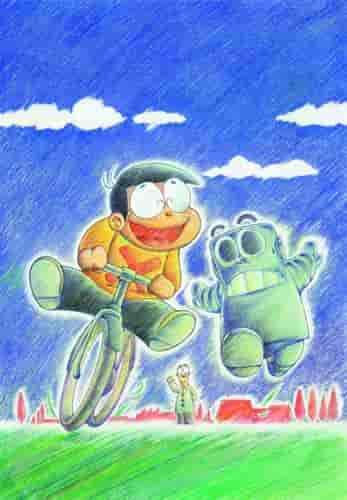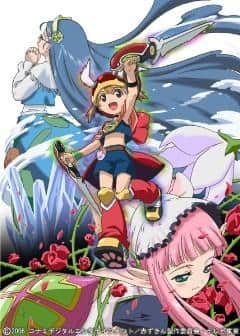The Merchant and the Monkeys: The ultimate battle for business and survival

"The Merchant and the Monkeys": The Humor and the Charm of Shadow Plays from the Muromachi Period■Overview of the work"The Merchant and the Monkeys" (Shonin to Sarunomure) is a Japanese animated film released in 1931. Set against the backdrop of the Muromachi period, the film depicts the humorous exchange between monkeys and merchants, and was produced as a record-talkie using shadow puppets. It is based on Tsubouchi Shoyo's children's play "Eboshi-ori and the Monkeys" and was produced by Teikoku Educational Film Company. This is a one-episode short animated film that was released in theaters. ■ StoryOne summer night during the Muromachi period, a group of monkeys were dancing around a hollow in a rock in honor of monkey sake on a mountain pass. The monkeys went to get some sake, and while they were there, a eboshi merchant passed by. He was on his way to deliver a golden eboshi hat at the request of a nobleman in the capital, and was taking a break near the monkey sake. At that moment, a fan merchant who had made a hinoki fan for a certain lady also arrived. The two showed each other their eboshi hats and hinoki fans, got drunk, danced, and then fell asleep. When the monkeys returned, they were angry that there was no monkey sake, and they ripped both the eboshi hat and the fan to shreds. The merchants were woken up by a noise and found the little monkey up in a tree wearing the golden eboshi hat and holding the hinoki fan, and they cleverly tricked the little monkeys into taking it back. This is the story. ■Explanation"The Merchant and the Monkeys" is a shadow puppet film adaptation of Tsubouchi Shoyo's children's play "The Eboshi-ori and the Monkeys." Shadow puppet animation combines the technology and artistry of the time, and also incorporates sound as a record-talkie. The film tells a story that combines humor and moral lessons against the backdrop of the customs and culture of the Muromachi period. The beauty of the shadow puppets, the movements of the monkeys, and the interactions between the merchants are beautifully expressed, making it a film that can be enjoyed both visually and aurally. ■ Main staff・Original story and adaptation: Shoyo Tsubouchi ・Supervision: Shoyo Tsubouchi ・Illustration: Ichiro Kanaiki ・Original illustration: Aoki Hosokibara ・Composition: Kiyoshi Yoshihara ・Dance choreography: Tamami Hanayagi ■ Appeal and evaluation of the work"The Merchant and the Monkeys" is an advanced work that uses the traditional expressive technique of shadow puppetry while incorporating record-talkies, the latest technology at the time. The beauty of the shadow puppetry and the smoothness of the movements enhance the visual appeal. The humorous movements of the monkeys and the interactions between the merchants provide laughs for the audience, but also contain moralistic elements. In particular, the scene in which the monkeys make a fuss for alcohol and the merchants use this to their advantage to get their things back reflects the customs of the Muromachi period, but also has a humor that is relevant today. This work has been praised for faithfully recreating the original work by Shoyo Tsubouchi, while taking advantage of the expressive power of animation. In particular, the drawings by Ichiro Kanaigi and the original drawings by Aoki Hosokihara pursue the beauty of shadow art and the realism of movement, maximizing the visual appeal. In addition, the composition by Noriyoshi Yoshihara and the dance choreography by Tamami Hanayagi play an important role in livening up the atmosphere of the story. ■ Historical background and influenceThe historical background of 1931 was a time when Japanese animation was still in its infancy. "The Merchant and the Monkeys" is an animation using shadow puppets that pursued both technical challenges and artistic expression, and influenced the subsequent development of Japanese animation. In particular, the use of sound, known as record talkies, had a major impact on later animation works, and became a catalyst for the pursuit of the fusion of sound and video. Based on a novel by Shoyo Tsubouchi, this work can also be said to be a pioneer in incorporating the children's drama genre into animation. By adapting a children's story into animation, it was possible to appeal to a wider audience and increase its educational value. In this respect, The Merchant and the Monkeys occupies an important place in the history of Japanese animation. ■ Recommendations and how to watch"The Merchant and the Monkeys" is recommended for those who want to enjoy a humorous story set against the backdrop of the customs and culture of the Muromachi period, those who are interested in the traditional method of expression known as shadow puppetry, and those who want to learn about the history of Japanese animation. It is a work that can be enjoyed by a wide range of age groups, from children to adults. Currently, it is possible to watch it on DVD or through online distribution services. It is also sometimes shown in movie theaters and at animation events, so it is a good idea to take advantage of these opportunities. Furthermore, by reading related books and materials, you can gain a deeper understanding of the background and production process of the work. Related works and referencesOther animations based on works by Shoyo Tsubouchi, such as "The Merchant and the Monkeys," and other animations using shadow puppets are also interesting. For example, by watching other animations based on Shoyo Tsubouchi's children's plays, or other animations using shadow puppets, you can understand this work from a broader perspective. References include the history of Japanese animation films, the collected works of Shoyo Tsubouchi, and books on the history and techniques of shadow art. Reading these materials will give you a deeper understanding of the background and production process of the works. Conclusion"The Merchant and the Monkeys" is a humorous story set against the backdrop of the customs and culture of the Muromachi period, told using the traditional expression technique of shadow puppetry and the latest technology of record-talkies. This work, which can be enjoyed both visually and aurally, occupies an important place in the history of Japanese animation and can be enjoyed by a wide range of age groups, from children to adults. We hope you will experience the charm and history of Japanese animation through this work. |
<<: Review of "Sora no Momotaro": A new adventure and a moving story
>>: The appeal and reputation of the manga "Spring": A thorough analysis of the moving story
Recommend
Movie "Sonic the Hedgehog" IGN 7 points: Made for Sonic fans
Today (February 13), the media ratings for the li...
"My Hometown and I" "The Road Back Home" trailer Wu Jing and Wang Yuan's earthy performances
"My Hometown and Me" released the trail...
50th Anniversary Kamen Rider New Movie Trailer Released on December 17th
The classic special effects film "Kamen Ride...
The appeal and reviews of "Backstreet Girls": Unexpected storyline and character depth
Backstreet Girls: From Yakuza to Idol "Backs...
The battle between my girlfriend and childhood friend is too harsh! Review and impressions of an anime that depicts realistic human relationships
"My Girlfriend and Childhood Friend are in a...
"Suicide Squad 2" is scheduled to be released in North America, and the director of "Guardians of the Galaxy Vol. 2" is expected to direct it
The DC movie "Suicide Squad 2" is sched...
Greek Mythology: A Deep Review of the Charming Stories and Characters
"You Can Do It: Greek Mythology": The f...
Netflix's new suspense crime film "God Forsaken" Chinese subtitle trailer starring Tom Holland
Recently, the Chinese subtitle trailer of Netflix...
The trailer for Junichi Okada's new film "Cerberus" will be released on September 16
The new movie "Cerberus" directed by Ma...
Bandai releases episode 6 of "Guinea Pig Cars" where guinea pigs encounter zombies
Today (February 9), Bandai officially released th...
Coca-Cola launches Star Wars OLED lightsaber bottle that can be lit up 500 times
"Star Wars 9: The Rise of Skywalker" is...
The appeal and evaluation of Invincible Robotrider G7: Experience the ultimate mecha action
Invincible Robotrider G7 - Invincible Robotrider ...
The Chinese sci-fi blockbuster "The Wandering Earth 2" will be released simultaneously in North America
According to media reports, the Chinese sci-fi bl...
The new series "Fall in Love with the Dress-Up Doll" is confirmed to be broadcast on January 8, 2022
The new anime "Falling in Love with Dress-Up...
The appeal and reviews of PHANTOM - The Legend of the Phantom Brave - RETURN THE SKY: In search of a return to the sky
The appeal and reviews of "PHANTOM - The Leg...









